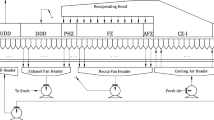Abstract
Mathematical models of straight-grate pellet induration processes have been developed and carefully validated by a number of workers over the past two decades. However, the subsequent exploitation of these models in process optimization is less clear, but obviously requires a sound understanding of how the key factors control the operation. In this article, we show how a thermokinetic model of pellet induration, validated against operating data from one of the Iron Ore Company of Canada (IOCC) lines in Canada, can be exploited in process optimization from the perspective of fuel efficiency, production rate, and product quality. Most existing processes are restricted in the options available for process optimization. Here, we review the role of each of the drying (D), preheating (PH), firing (F), after-firing (AF), and cooling (C) phases of the induration process. We then use the induration process model to evaluate whether the first drying zone is best to use on the up- or down-draft gas-flow stream, and we optimize the on-gas temperature profile in the hood of the PH, F, and AF zones, to reduce the burner fuel by at least 10 pct over the long term. Finally, we consider how efficient and flexible the process could be if some of the structural constraints were removed (i.e., addressed at the design stage). The analysis suggests it should be possible to reduce the burner fuel lead by 35 pct, easily increase production by 5+ pct, and improve pellet quality.
Similar content being viewed by others
References
INDSYS, PERI, Salt Lake City, UT.
N.A. Hasenack, P.A.M. Lebelle, and J.J. Kooy: in Mathematical Process Models in Iron- and Steel-Making, TMS, Warrendale, PA, 1975, pp. 6–16.
R. Drugge: “Modelling of Heat Exchange Phenomena during the Induration of Magnetite Pellets on a Moving Grate,” AIME-SME Preprint No. 75-B-51, AIME-SME, New York, NY, 1975.
R. Drugge: in Agglomeration 81, O. Molerus and W. Hufragel, eds., Nurnberg, 1981, pp. B36–B57.
J.A. Thurlby, R.J. Batterham, and R.E. Turner: Int. J. Mineral Proc., 1979, vol. 6, pp. 43–64.
J.A. Thurlby: Metall. Trans. B, 1988, vol. 19B, pp. 103–12.
J.A. Thurlby: Metall. Trans. B, 1988, vol. 19B, pp. 113–21.
J.A. Thurlby: Metall. Trans. B, 1988, vol. 19B, pp. 123–32.
R.W. Young, M. Cross, and R.D. Gibson: Ironmaking and Steelmaking, 1979, vol. 6, pp. 1–15.
M. Cross, E.C. Bogren, J.S. Wakeman, and R.D. Frans: Applications of Mathematical and Physical Models in the Iron and Steel Industry, Proc. 3rd PTD Conf., ISS-AIME, Warrendale, PA, 1982, pp. 101–09.
M. Cross and D. Englund: in Mathematical Modelling of Materials Processing Operations, J. Szekely et al., TMS, Warrendale, PA, 1987, pp. 509–22.
M. Cross and K.C. Wade: Proc. 5th Int. Symp. on Agglomeration, M. Cross and R. Oliver, eds., IChemE, London, UK, 1989, pp. 291–98.
R.W. Young: Ironmaking and Steelmaking, 1977, vol. 6, p. 321.
S.V. Patankar: Numerical Heat Transfer and Fluid Flow, Hemisphere, Washington, DC, 1980.
Author information
Authors and Affiliations
Rights and permissions
About this article
Cite this article
Cross, M., Blot, P. Optimizing the operation of straight-grate iron-ore pellet induration systems using process models. Metall Mater Trans B 30, 803–813 (1999). https://doi.org/10.1007/s11663-999-0042-5
Received:
Issue Date:
DOI: https://doi.org/10.1007/s11663-999-0042-5




